Spotlight > Whistle Categories > Variety > 126 GAI Whistle Punches
Whistory
Typically, the study of vintage whistles takes us back many years, more often than not, pre 1920 and occasionally post 1920 comes a whistle here or there. With GAI Whistle Punches, it is a delight to find a whole subgroup starting from the 1930s. With world commerce and communication opening up, we can learn more about vintage whistles now. Here we are presenting from Russian history, innovative and varied whistles in combination with punches — as a subgroup of vintage whistles.
Where did GAI Whistle Punches originate?
These were originally issued as singular punches with independent whistles and the need or desire arose to have the two in combination. Craftsmen, in artels – small village coops or workshops, at larger city factories or in prison workshops. They created imaginative designs and used mixed materials to suit the needs. Because of naturally small orders, each whistle could be hand crafted and perhaps even be unique, so that a tremendous variety is found.
What time period are GAI Whistle Punches from?
Different accounts build a historic background:
A few years after the Bolshevik Revolution, the new proletarian state accepted driver’s licenses issued by the Tsarist state. In 1923, however, the Soviet government issued its own “Certificate on the Right to Drive a Carriage.” Drivers were divided into three categories according to length of service. At the same time, certificates were issued by local authorities, and sometimes authorities in one region refused to recognize papers issued by another.
In 1936, a single version appeared, a driver’s certificate, which came under the jurisdiction of the Interior Ministry. GAI, the State Automobile Inspectorate, was also established in the USSR that same year.
In 1968, the Soviet Union joined the Vienna Convention on Road Traffic, and the Soviet driver’s license became internationally recognized. Somewhat later, all means of transportation in the USSR were divided into five categories: A, B, C, D and E.
There was a system of ‘points’ in the USSR for breaking traffic rules. A driver could get up to three such ‘points,’ which were marked as holes in a special coupon. After the third hole, you turned into a pedestrian.
Whistle Archeology
Cars for Comrades the Life of the Soviet Automobile reads:
‘It is difficult to be precise about when the traffic police —- both “ORUDtsy” ( road traffic control department 1931 to 1961 ) and GAIshniki 1936 to 1961 ( ORUD and GAI merged 1961 i.e.RUD_GAI. The shortened name GAI until 1998. —- acquired their reputation for dishonesty. Taking bribes from motorists who violate traffic rules is not necessarily universal among police forces, but it appears to be widespread.
The problem in the Soviet Union was that traffic police had unusually wide latitude in assessing code violations. The punching of a hole in a driver’s license to indicate an infraction – a practice that was adopted for the entire country in the course of the 1960s – virtually invited bribes, especially by those who were in danger of getting the dreaded third hole that spelled suspension.
Konstantin Simis, a former defense lawyer who left the Soviet Union in 1977, noted that “at the slightest infraction – and even for no reason at all – the GAII inspector will flag down a private car with a grandiose gesture of his police baton and will adopt a monumental pose, not moving from his spot, waiting for the driver to come up to him at an obsequious trot.” He adds that the standard rate for avoiding a hole in one’s license was a mere one ruble if there were no previous violations, three to five if the license already was penalized, and fifty rubles if alcohol could be smelled on one’s breath.
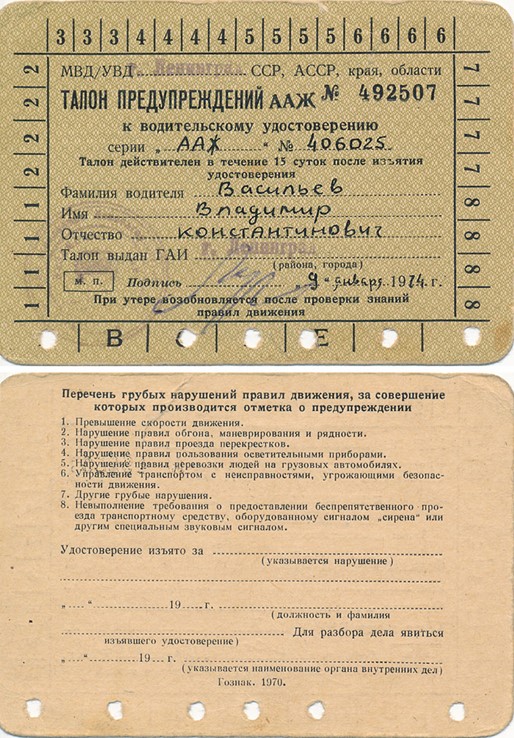
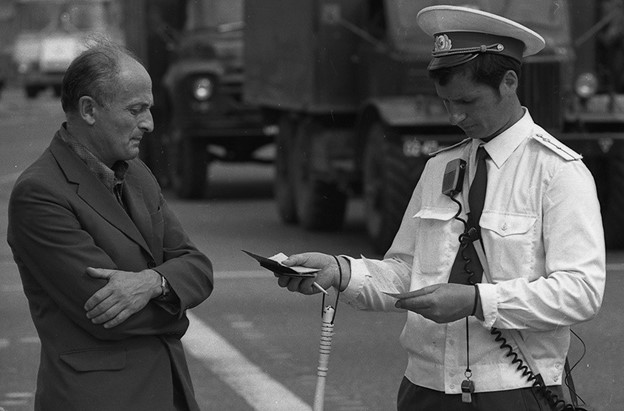
Another account reads:
Soviet Communist Russia had strict laws.
When you were issued a new car license, a green paper insert was attached to it. If you violated the rules of the road for the first time – you made a hole on the insert with a hole punch, if the second time – a second hole, if you violated the third time and you made a third hole then you were taken away from the car license and sent to take the exam on the rules of the road again.
All drivers were afraid of this retake, because it took a lot of time and nerves ( in Soviet times, there were huge queues everywhere).When the police inspector stopped the driver and was going to make a hole in the Deposit-the driver begged him to pay a fine at the scene of the violation , but not to make a hole in the Deposit-in fact, it was meant that the driver would pay a bribe to the inspector and go on.
How were GAI Whistle Punches issued?
You may ask – how did these hole – punch whistles get to the traffic police?
Guys in tattoos, who were released from prison, took with them such whistles made in prison from improvised materials, or passed these whistles outside the prison. If the traffic inspector stopped such a “guy in tattoos”, the guy gave a gift of such a whistle to the inspector and drove on. Everyone got their own-the inspector got an elegant, individualized handmade item that he could use in everyday work, and the “driver in tattoos” saved his money.
( The punch and whistle were originally issued separately. )
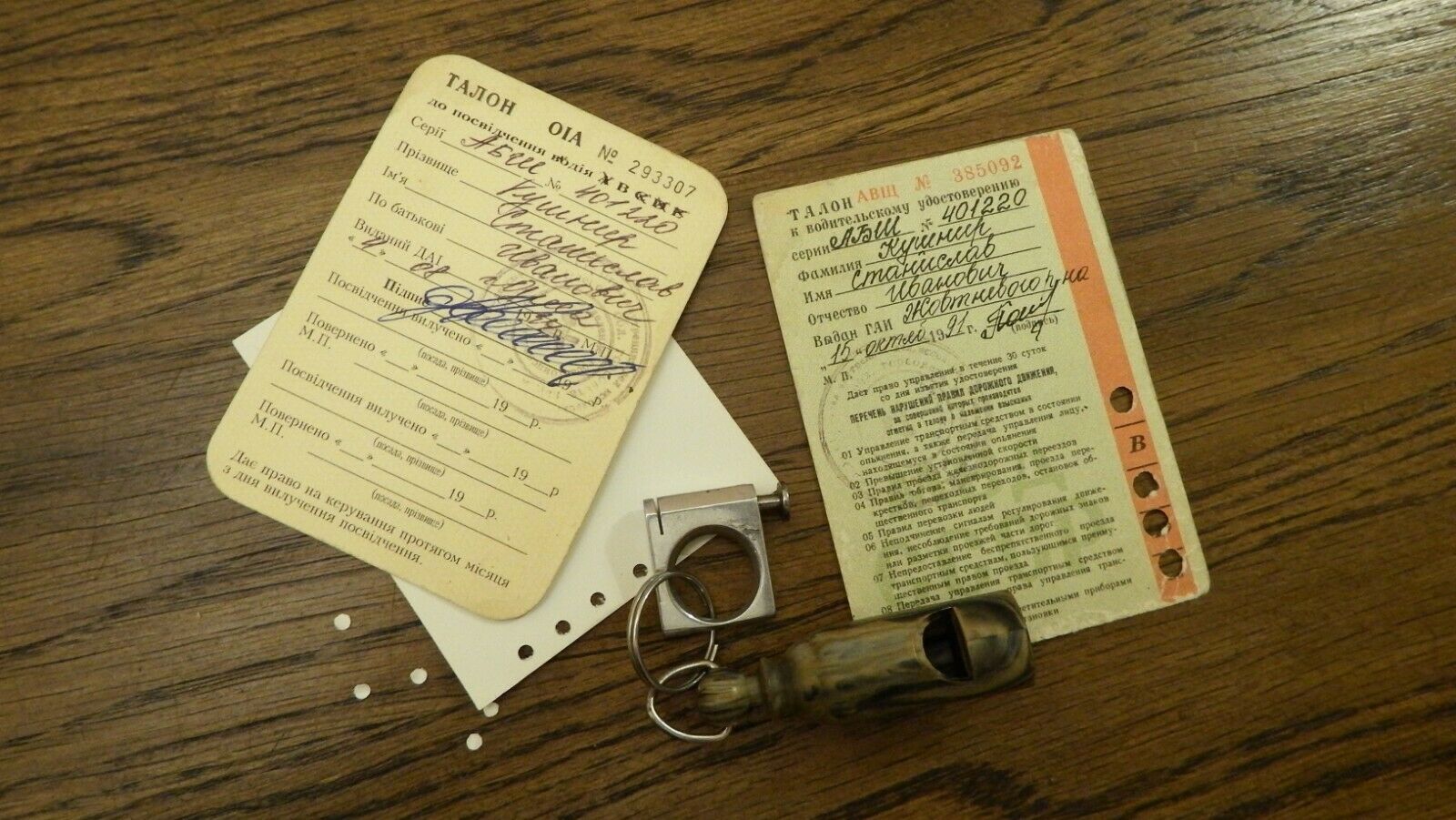
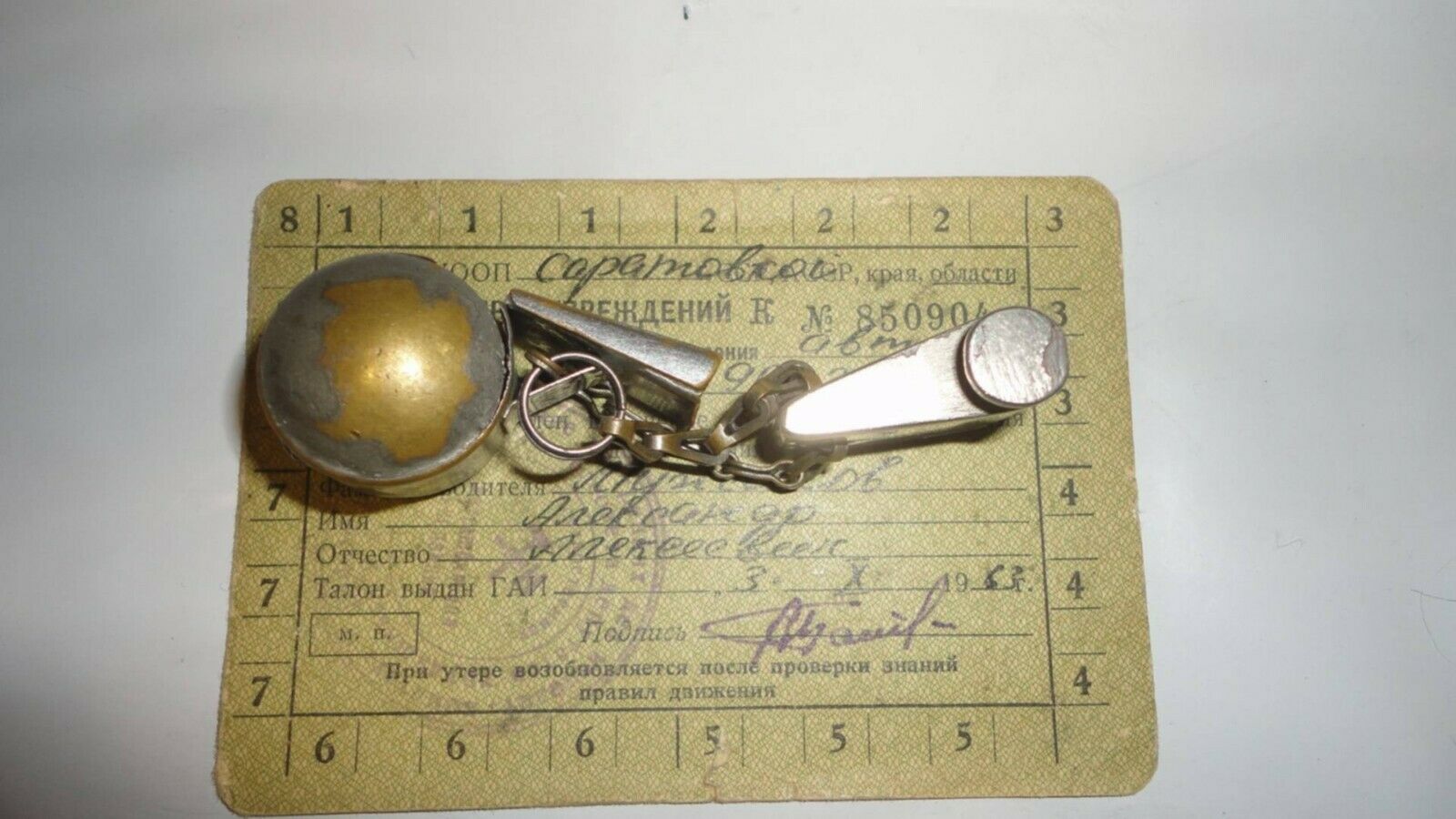
However, the transport police could have them combined or more often, fabricated from scratch, by ordering from small workshops in prisons, small factories by special order in small batches. Each employee could manufacture his own if he had the skill. Therefore, these whistles could come in a variety of creations.
Whistology
| Category | GAI Punches |
| Classes | with ring without ring |
| Groups | Metal Plastic Carbolite |
| Subclass | Laminated Non-Laminated Carved Deco |
For the punch itself different metals could be used ( i.e. aluminum, brass, steel, plated metals ) as well as a popularly used material in Russia – carbolite, a bakelite product was used in combination with the punches and can be found in an amazing array of ‘round’ whistle shapes. Furthermore, plastic, bone, resins, amber, whatever could be found and crafted could be used in various combinations, as well as stacked laminations.
In examining the different parts of these ‘gadget’ whistles, we can first start with the most common material used for round whistles attached to the punches – Carbolite – It is described analytically as a phenol formaldehyde resin analogous to Bakelite used in Russian Empire and the Soviet Union. ( Carbolic acid ).
This material lends itself to crafting whistle bodies and fipples and at the same time is very resilient. The connections to the metal punch sides stays strong for years of use and abuse.
Many times, the main body, when it is all metal, is one solid piece of turned metal, which must be cut and filed for the square or angle ends. Attachment loops are also ‘fashioned’ according to the whistle body design, leaving room for further variety because of the ‘necks’ or a bluntly attached punch without a neck.
The punches come with a variety of top caps and spring arrangements which leads to yet even further individualism. We therefore see rarely two alike or when we do, these whistles do not closely match, as if they were ever production whistles, so that they were very custom made, — perhaps even by order.
Therefore, we find variety in the following aspects:
- The attachment points for the wire loops
- Wire loop shapes
- No wire loop, handheld only
- Materials of metal for the punches
- Materials for the whistles
- Window shapes
- Fipple Shapes
- Sizes
- Sound
- Exposed springs
- Non exposed springs
- Punch top caps
- Paper slit shape
- Punch head
- Necks or no necks between whistle and punch
Similarities are:
- All metal
- Carbolite rounds
From this list, it can be understood why there is a tremendous amount of variability. In fact, at this point, we have seen no two alike, although some have proven similar. But it is a new study project.
What also proves to be amazing is how many talented craftsmen are able to build from scratch the dynamics of whistle construction. The mouthpiece angles, the size and sound, the windows.
Typically, whistle making has been refined within companies over time by whistle manufacturers, but here, many sources were tapped to produce what was thought to be left to ‘whistle makers’. So, these ‘gadget whistles’ prove to be insightful from another angle.
First a group picture of GAI Whistle Punches:
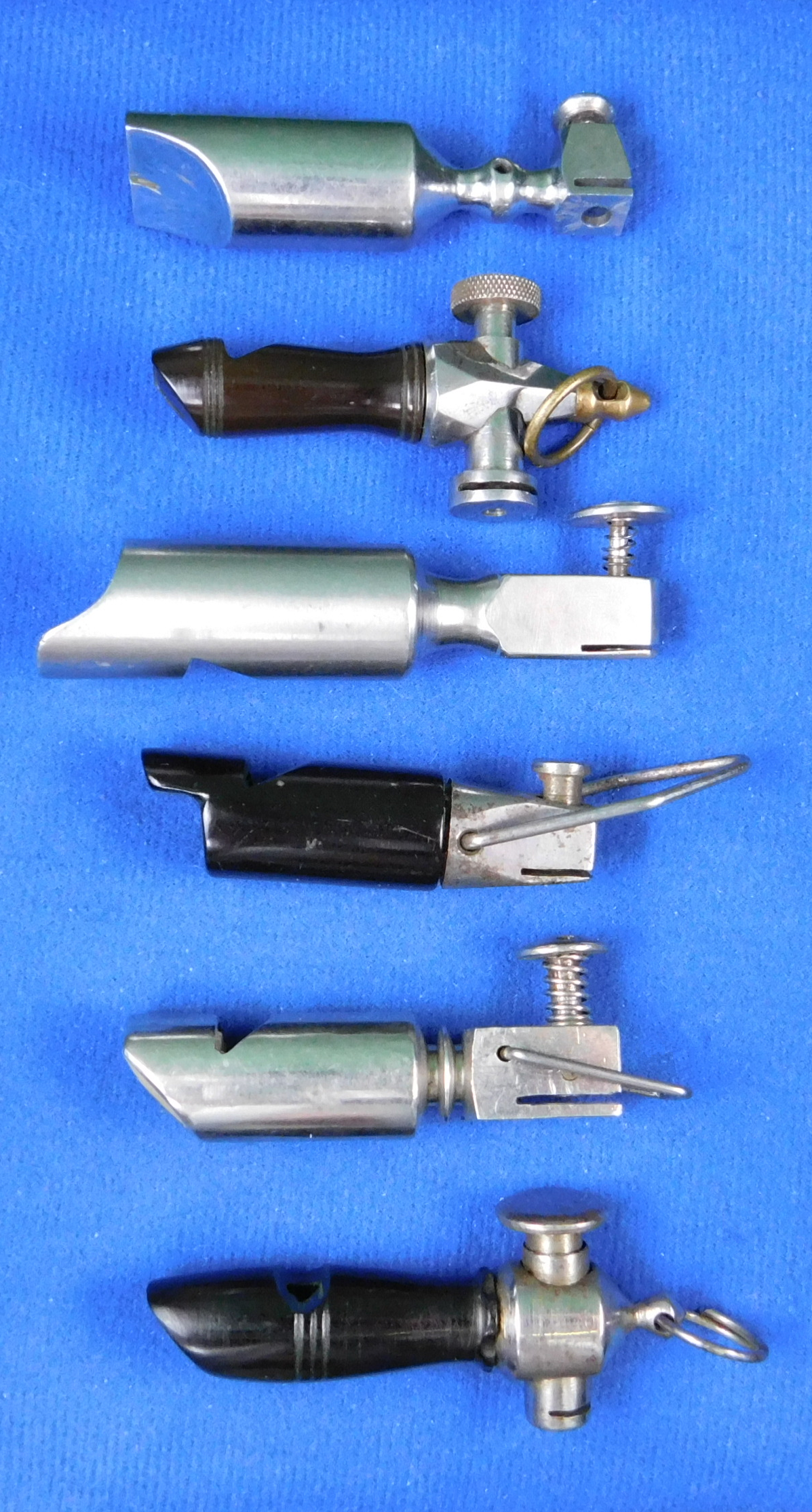
Conclusions:
In the world of whistle collecting and studies, these are late comers. Circa 1930 to 2000. For the punch itself different metals could be used ( i.e. aluminum, brass, steel, plated metals ) as well as a popularly used material in Russia – carbolite, a Bakelite product was used in combination with the punches and can be found in an amazing array of ‘round’ whistle shapes. Furthermore, plastic, bone, resins, amber, whatever could be found and crafted could be used in various combinations, as well as stacked laminations.
This has created a potentially large category of whistle study and collecting.
TWG
Posted December 5, 2021
Bibliography:
https://www.rbth.com/history/329012-car-drivers-license-russia – Russia Beyond –
Cars for Comrades The Life of the Soviet Automobile
wiktionary










